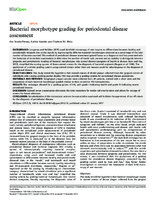Bacterial morphotype grading for periodontal disease assessment

View/
Date
2017Author
Smeda-Pienaar, Kim
Kaambo, Eveline
Africa, Charlene W.J.
Metadata
Show full item recordAbstract
BACKGROUND: Listgarten and Hellden (1978) used darkfield microscopy of wet mounts to differentiate between healthy and
periodontally diseased sites in the mouth by expressing the different bacterial morphotypes observed as a percentage of the total
number of bacteria counted. This method of periodontal disease assessment gained favour as a diagnostic tool but presented with
the limitation of immediate examination to determine the number of motile rods present and an inability to distinguish between
gingivitis and periodontitis. Grading of bacterial morphotypes into several distinct categories of health or disease (Ison and Hay,
2002), simplified the scoring system of Gram-stained smears for the diagnosis of bacterial vaginosis (Nugent et al. 1991). The
application of a similar grading system using stained smears rather than wet mounts could be advantageous to the diagnosis of
periodontal disease.
OBJECTIVES/AIMS: This study tested the hypothesis that stained smears of dental plaque collected from the gingival crevice of
individuals with varying probing pocket depths (PD) may provide a grading system for periodontal disease assessment.
MATERIALS AND METHODS: Subgingival plaque samples were collected from 49 patients, stained with a silver stain and the
proportions of each bacterial morphotype graded relative to their respective PD measurements.
RESULTS: This technique allowed for a grading system of I–IV, with grade I indicating health and grade IV indicating severe
periodontal disease.
DISCUSSION: Stained smear examination eliminates the time restriction for motile rod enumeration and allows for storage of
smears for future reference.
CONCLUSION: Standardization of the microscopic areas to be evaluated or examined will facilitate the agreement of cut-off values
for the diagnosis of periodontal disease.
